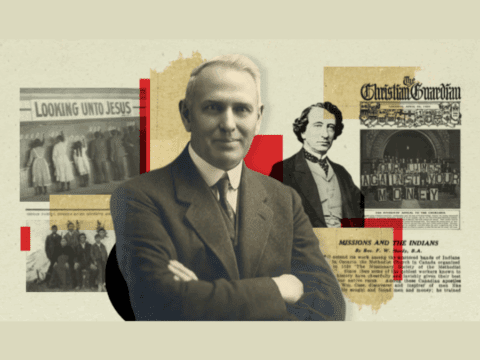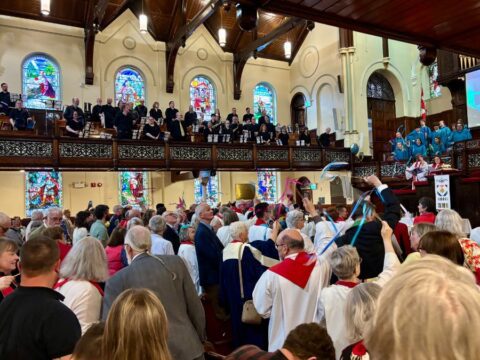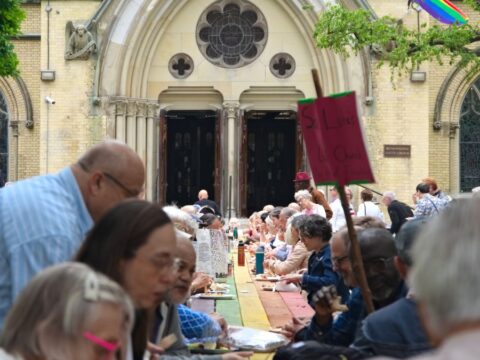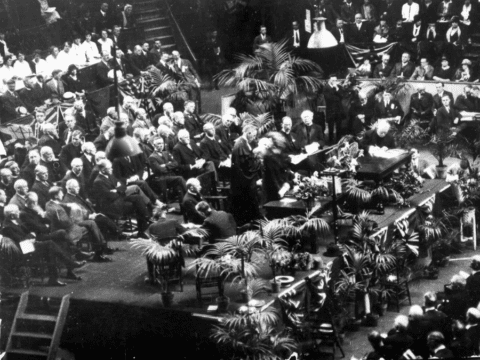I am a necktie preacher. Actually, I am a take-off-the-jacket-and-roll-up-the-sleeves necktie preacher. I wasn’t always. When I was first ordained, I wore a clerical collar on Sunday mornings. Why? Because for a few years, it helped me get into the role of worship leader. It was a costume, and I like costumes.
Besides, I don’t like ties. Well, I do, but I am easily bored by them. After I’ve worn a tie two or three times, I want to send it to the clothing depot and get a new one. But ties are expensive, so I keep wearing the same ones. That’s something else to like about clergy shirts or blouses — they take the decision-making out of getting dressed in the morning.
Now that I’m in team ministry, it would seem snooty to wear a collar when my colleague, a lay minister, can’t. So I’m a necktie preacher. Except for funerals, when I wear a collar because I think it helps unchurched people figure out what my role is. When I leave the church, I remove the white “tab” — actually a strip of plastic that slips in and out of the shirt.
Clearly, I am as conflicted about clerical costumery as many other United Church folks. When The Observer challenged me to wear a collar every day for a month, I accepted because I was curious to discover what that would be like.
I hadn’t considered how difficult it would be. I own only three clergy shirts (black, grey, navy), and those are hand-me-downs, given to me by a colleague who had sworn off wearing a collar. His neck size is a little larger than mine, so when I wear one of his shirts, I look like I have recently lost some weight. The two biggest hurdles I had to overcome in completing this challenge were (1) laundry and (2) convincing friends that I wasn’t on a diet.
The results of this experiment, I have to admit, were less than spectacular. Nobody invited me to go ahead of them in line at Tim Hortons. Neither did anyone openly sneer at me. What I mostly noticed was that people gazed at me a little longer. They didn’t stare, exactly, but they gave me an appraising look, their eyes moving from the collar to my face and back to the collar. They could have been thinking, “He looks like someone I could tell my troubles to.” But they could just as easily have been thinking, “He looks like a child molester.” Or maybe, “He looks like he lost some weight.” I couldn’t tell. But they definitely noticed. I felt on display, like a used car with a sign in the window (Driven only on Sundays!). I was making some kind of claim about myself, but most of the people I met seemed as puzzled about the nature of that claim as I was.
A quick Internet search revealed that I had been wearing my collar all wrong. Clergy shirts were never intended to be reserved for special occasions like leading worship. Quite the opposite, in fact — they are supposed to be worn every day. Their purpose is to make clergy identifiable — and therefore approachable — outside the church, not inside. They eliminate the need for that question from an airplane seatmate that all ministers dread: “So, what do you do?” When you’re wearing a collar, everyone already knows.
The Church of Rome has long encouraged its clergy to wear something that would identify them as priests. For centuries, that something was a cassock — an ankle-length robe that buttons up the front.
The modern clergy collar first appeared in the 19th century, its creation attributed to Rev. Dr. Donald McLeod, a Scottish Presbyterian. Today, the Protestant invention has become standard apparel for Roman Catholic priests. Even the Pope wears one. During my month-long experiment, I was startled on a couple of occasions to be called “Father” by people who were not my children.
An ex-priest friend of mine says that although clergy shirts have replaced the cassock, the purpose is the same. “It’s a uniform,” he says, “just like a nurse’s uniform. Nurses don’t wear a uniform because they think they’re better than everyone else. It’s so people know who to look for when they need a nurse.” I had never thought of it that way. Of course, nurses no longer dress in white or wear starched caps, and it’s increasingly difficult to tell RNs from orderlies from surgeons.
Still, if medical staff can wear special clothing at work and not be thought to be demanding special status, why can’t ministers? I was wearing my collar one day when I stopped to talk to some children from the preschool that meets in our church. One four-year-old boy looked up at me with big eyes. “Are you a policeman?” he asked. No, but he had the right idea. I was a man in uniform.
The real test, however, was with those who already knew me without the collar. Congregation members were certain that something special was afoot. “You’ve got a funeral today?” they asked, surprised not to have heard about it. Clearly, I had trained them well in the incorrect usage of clerical collars.
It was at an all-day meeting of Presbytery that things got really interesting. Here in Saskatchewan Conference, where people routinely wear jeans to church, we seldom stand on formality. Lay ministry is respected, and people who toss around titles like “reverend” are seen as hopelessly out of touch. As I took my black clergy shirt out of the dryer the night before the meeting, I knew it would be noticed.
At coffee break, several individuals approached me in turn. “What’s with the collar?” said one. “Is this a new look for you?” asked another. One woman got right to the point. “Who do you think you are?” she said. I hastened to reassure them that I hadn’t had a sudden attack of pomposity. “It’s just an experiment,” I said.
Later, I wondered why I had been so apologetic. Are we so uncomfortable in the United Church with ministry — and ordination in particular — and whatever authority may be attached to it that ministers can no longer look like ministers?
On a more intuitive level, however, I knew exactly what the fuss was about. In a room full of people, all exercising their call to ministry in the service of the church, why would I alone feel the need to identify myself as having a particular kind of calling? The truth is, I felt pretentious.
In fact, it is my own reaction to the collar that is most telling. As the novelty wore off, I began, like Frodo, to feel the weight of the ring around my neck. First, with my top shirt button done up and the collar tab inserted, I felt dressed up, and therefore, for most occasions, overdressed — as if I had worn a tuxedo to a barn dance. I couldn’t bear the mixed message of wearing jeans (I’m a worker!) with a clergy shirt (I’m a professional!), so I always wore slacks (more laundry!). I looked more formal on the outside than I felt on the inside.
More than that, I felt that I was on constant display. I had lost my anonymity. Everyone who saw me knew that I represented church; indeed, that I represented Christ. At the hospital, the gas station, the coffee shop, the store on the way home, I became conscious of how my faith is played out in human interactions. I became very self-conscious, for example, when stopping at the local liquor store for a bottle of wine. It’s not that I think there’s anything wrong with a person of faith — even a minister — drinking wine. It’s that I still have some emotional baggage from attending a Baptist Sunday school. And whether or not it had anything to do with the collar, the woman behind the till was unusually chatty as I paid for my Cabernet.
In other words, being collared was a revealing and productive spiritual practice. Muslims acknowledge their faith with prayer five times a day. Jews make faith decisions every time they choose kosher. Catholics wear a crucifix. United Church people, like other mainline Protestants, don’t have a practice that sets us apart as people of faith. We don’t wear anything that identifies us as followers of Jesus, don’t put ourselves on display so that others can see what faith in action looks like. I began to think we’re missing out on something.
Does this mean that I’m going to buy more clergy shirts, so I can wear one every day and still do a weekly laundry? No. In the end, I find a collar is just too dressy for everyday wear. By the end of the month, I thoroughly resented it. It’s just not who I am — or who I want to be. Still, I will miss the spiritual awareness it engendered. Maybe, I thought, I should wear it for Lent.
But I won’t. Because there is also a spiritual discipline in not wearing a clergy shirt. Going collarless reminds me of my deeply held belief in the priesthood of all believers. Ordination is sometimes referred to as a “higher calling.” It is not, at least not in my view. God calls each one of us to a vocation, whether it is preaching on Sunday or driving a truck. Some callings may require more responsibility than others, but none is any higher than the rest. And I have a closetful of perfectly ordinary shirts that I will wear to reinforce that message every day.
This story originally appeared in the February 2012 issue of The Observer with the title “Collared.”
















Interesting thoughts on both sides of the collar. There is something to be said in identifying one as a follower of Christ, but it does also allow one’s actions to be judged. I choose to wear a small cross necklace to remind myself everytime I look in the mirror our touch my necklace that I am trying to follow Jesus’ way. I do find it helpful to have that identifiable symbol, and I suppose a collar would be a similar symbol though even more so. It does mean mean that I watch what I say and do more closely then I would, perhaps, if I were not wearing a cross. I am aware that I represent, to some extent, Christianity when I am wearing the cross, and I am more conscious of my behaviour. I think symbols can be very important, however, there certainly may be times when we do not want to put ourselves in that position, identifying ourselves as such. Interesting thoughts. Thank you for the article.